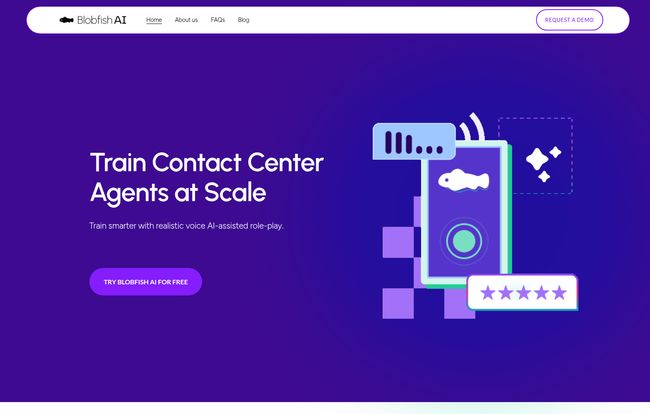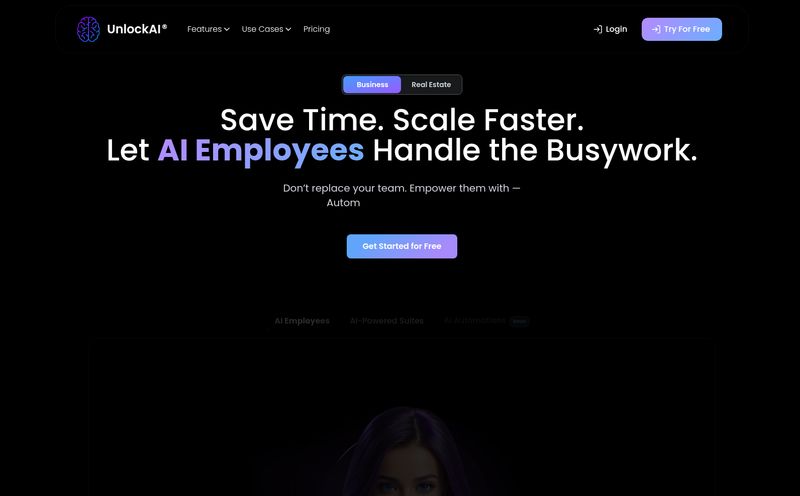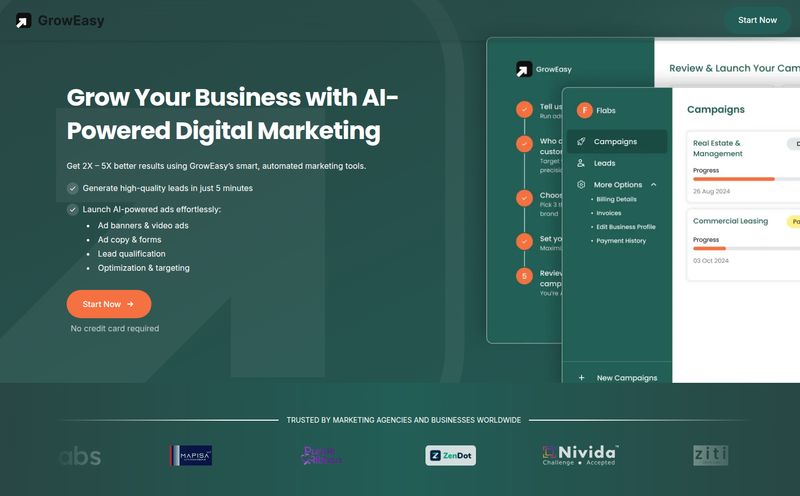If you've ever worked in sales, you know the sound. That monotonous, soul-crushing dial tone, followed by the inevitable voicemail prompt. Cold calling is a numbers game, and frankly, the numbers usually suck. You spend hours dialing just to get a few precious conversations. It’s a grind. A necessary evil we’ve all just sort of... accepted.
But what if we didn't have to? Every few years, a new tool pops up promising to revolutionize outbound sales. Most of them are just shinier versions of the same old autodialer. But every so often, something genuinely different comes along. I've been hearing whispers about a platform called Blobfish AI, and the claims are, let's say, ambitious. An AI that doesn't just dial for you, but actually has human-like conversations to qualify leads? Yeah, okay. I was skeptical too.
So, I decided to put on my investigator hat, wade through the marketing jargon, and figure out what this thing is all about. Is Blobfish AI just another drop in the ocean of sales tech, or is it the apex predator we've been waiting for?

Visit Blobfish AI
So, What on Earth is Blobfish AI?
Forget everything you think you know about dialers. Blobfish AI isn’t just a machine that burns through a call list. Think of it more like a cyborg Sales Development Rep (SDR). It’s an AI-powered dialer designed to handle the most draining part of the sales process: the initial outreach and qualification.
At its core, Blobfish automates outbound calling. But the magic, or at least the advertised magic, is in the conversation. It uses a startlingly natural-sounding AI voice to talk to prospects, navigate gatekeepers, handle initial objections (“I’m busy right now,” “Just send me an email”), and ask intelligent qualifying questions. Its entire purpose is to sift through the mud to find the gold, so your human sales team only talks to warm, qualified leads who have already agreed to a meeting.
It even schedules the appointments directly onto your team’s calendar. It’s like having a fleet of tireless, highly-caffeinated robot assistants who never need a coffee break and actually enjoy getting told “no.” A wild concept, I know.
The Features That Make Blobfish Stand Out (Or Try To)
Plenty of tools can dial a number. But Blobfish is betting its entire reputation on a few key features that set it apart from the pack.
The Uncannily Human-Like AI Voice
This is the big one. We've all been on the receiving end of a robocall. You know, that choppy, dead-eyed voice that makes you want to hang up before it even finishes its first sentence. Blobfish claims to have cracked that code. The AI is designed to have natural intonation, pacing, and even the ability to react to interruptions. The goal is for the person on the other end not to realize they're talking to an AI. A bold claim, and one that, if true, changes the game completely.
That Jaw-Dropping 70% Connection Rate
Okay, when I first saw this number, I rolled my eyes. A 70% connection rate? In what universe? Most good SDR teams are happy to hit 10-15%. But here's the thing: Blobfish isn't measuring connection in the same way. This isn't just about someone picking up the phone. Their metric seems to be about getting past the initial dial tone and having a conversation start. Still, even if we take it with a grain of salt, the promise of dramatically increasing the number of actual conversations is the holy grail for any sales manager. They also claim this leads to a 35% reduction in cost per qualified lead, which is a number that makes CFOs sit up and pay attention.
Seamless Integration with Your Existing Stack
A new tool is only as good as its ability to play nice with others. There’s nothing worse than having to manually port data between systems. It’s 2024, for crying out loud. Blobfish seems to get this. It integrates directly with major players in the sales and marketing world, like HubSpot and Apollo.io, plus it plugs right into Google Calendar for scheduling. This means it can pull lead lists, log call activity, update contact records, and schedule meetings without your team having to lift a finger. That's not just convenient; it's a massive time-saver that prevents important data from getting lost in the shuffle.
The Good, The Bad, and The AI: My Honest Take
No tool is perfect. Let's get that out of the way. While the potential here is huge, you have to go in with your eyes open. On one hand, the efficiency gains are undeniable. Automating the top of the funnel is a dream for any scaling business. It lets your highly-paid, highly-skilled sales closers do what they do best: close deals. Instead of spending 80% of their day hunting, they can spend it selling.
But then there's the flip side. You're putting a lot of trust in an algorithm. What if the AI misinterprets a prospect's sarcastic comment or a complex, industry-specific question? The provided documentation admits this is a possibility. You can't just set it and forget it entirely. This system requires initial setup to define the conversation flows and ongoing monitoring to make sure the AI isn't going rogue and booking meetings with completely unqualified leads. It’s a powerful tool, not a magic wand. You still need a human brain to oversee the operation and refine teh strategy.
Here’s a quick breakdown of how I see it:
| The Wins (What I'm Excited About) | The Watch-Outs (What Gives Me Pause) |
|---|---|
| Massive efficiency boost for sales teams. More time selling, less time dialing. | Requires initial configuration. Not exactly a plug-and-play solution. |
| Potentially huge reduction in cost-per-lead. Makes outbound scalable. | The AI isn't infallible. It could misinterpret nuance and needs monitoring. |
| Consistent, 24/7 outreach. The AI never has a bad day or call reluctance. | Relies heavily on the quality of your lead list and the scripts you build. |
Who Is This AI Dialer Really For?
Blobfish AI isn't for everyone. If you're a solopreneur who relies on a handful of high-touch, personal relationships, this is probably overkill.
But if you're a B2B company with a dedicated sales team, especially one that's struggling to hit outbound quotas or scale effectively, this could be a game-changer. I see it being a perfect fit for:
- High-growth startups looking to build a sales pipeline without hiring a massive SDR team from the get-go.
- Established companies with long sales cycles that need a consistent flow of qualified meetings for their account executives.
- Sales teams that are burning out on traditional cold calling and seeing diminishing returns.
- Marketing agencies that offer lead generation as a service and want to add a powerful, scalable tool to their arsenal.
Essentially, if your business model relies on a high volume of top-of-funnel activity to succeed, this is a tool you should be looking at. Seriously.
What's the Damage? A Look at Blobfish AI Pricing
Ah, the million-dollar question. Or, hopefully, a lot less than that. If you go to the Blobfish AI site looking for a pricing page, you'll be... looking for a while. There isn't one.
Instead, they use the classic B2B SaaS model: "Request a Demo."
Don't let that scare you off. It's pretty standard for specialized tools like this. It usually means the pricing is customized based on your needs—things like the number of users, call volume, and the specific integrations you require. It's not a one-size-fits-all product. While I can't give you a hard number, this approach means you'll have a conversation with their team to see if it's even a good fit before you talk dollars and cents. It prevents sticker shock and ensures you're not paying for features you'll never use. My advice? Go into the demo with a clear idea of your budget and your goals.
Frequently Asked Questions about Blobfish AI
Is Blobfish AI just another robocaller?
Not really. While it does automate calls, its main differentiator is the conversational AI. Unlike a traditional robocaller that just plays a recording, Blobfish is designed to have a two-way, human-like conversation to qualify the lead before handing it off.
Can I customize the scripts and conversation flows?
Yes. The platform is built around customization. You need to configure the conversation flows, key qualifying questions, and objection handling based on your specific industry, product, and sales process. This is part of the initial setup.
What languages does the AI support?
While their primary marketing focuses on English, you would need to confirm the full range of supported languages during a demo. For platforms like this, expanding language capabilities is often a top priority based on client demand.
Is it difficult to set up?
It's more involved than, say, downloading a new app on your phone. It requires a thoughtful setup process where you define your goals and scripts. However, given its integrations with tools like HubSpot and Apollo, the technical side of connecting your data should be relatively straightforward. Expect to invest some time upfront to get it right.
What happens if the AI can't answer a question?
This is a key part of the setup. A good conversational flow includes a fallback plan. This could involve the AI saying something like, "That's a great question, and I want to make sure I get you the right answer. Let me schedule a brief call for you with a specialist who can cover that in detail." Its goal is to book the meeting, not to be an all-knowing encyclopedia.
Final Thoughts: Is It Worth a Shot?
After digging in, my initial skepticism has turned into cautious optimism. Blobfish AI is stepping into a space that's ripe for disruption. The daily grind of manual cold calling is a huge pain point for so many businesses, and the idea of automating it with an AI that's actually good at talking to people is incredibly compelling.
It’s not a magic bullet. You can’t just buy it and expect leads to rain from the sky. It requires strategy, setup, and oversight. But for the right team—one that's ready to embrace automation and refine its process—Blobfish AI could be the difference between stagnating and scaling. It represents a shift from brute force to intelligent automation.
If you're tired of hearing that dial tone, it might be time to request a demo and hear what the future of sales outreach sounds like for yourself.



